Choosing the Perfect Shower Head for Bath Taps


Intro
Choosing a shower head that fits bath taps may seem trivial, yet it holds significant influence over both comfort and functionality in daily routines. This guide aims to demystify the selection process, making it accessible for homeowners and renters alike.
Understanding various types of shower heads available in the market, as well as their installation techniques and compatibility with bath taps, is essential. Furthermore, maintenance tips contribute to the longevity and efficient performance of these fixtures. Each aspect plays a crucial role in elevating the overall bathing experience.
In reading this, you will gain insights not only into the practical aspects of selecting shower heads but also into trends and aesthetics that can seamlessly integrate into any bathroom space.
Trending Styles
Modern Minimalism
Modern minimalism emphasizes simplicity and functionality. Shower heads in this style typically feature sleek lines and straightforward designs. High-quality materials such as stainless steel or matte black finishes dominate this trend. With clean profiles and uncluttered aesthetics, modern minimalist shower heads can transform the appearance of any bathroom.
Consideration should also be given to their functionality. Many models in this category come equipped with adjustable spray settings, which enhance versatility while maintaining an elegant look.
Cozy Rustic
Cozy rustic shower heads aim to blend comfort with charm. Often crafted from natural materials or featuring a vintage appearance, these models evoke a sense of warmth. Features like bronze or brass finishes provide a timeless allure that complements rustic decor themes.
For those who prefer a more homey feel, a rustic shower head can enhance the bathing experience, adding character to what is often a utilitarian space.
Color Palettes
Calming Neutrals
Neutral colors generally provide a calming atmosphere in the bathroom. Shades like soft whites, creams, and taupes work well with various shower head styles. These colors can promote relaxation, making them a suitable choice for those looking to unwind during their bathing ritual. When paired with neutral palettes, a simplistic shower head can seamlessly blend, allowing for a unified aesthetic throughout the space.
Bold Accents
In contrast, bold accents can create an eye-catching focal point in the bathroom. Shower heads in vibrant colors, such as deep blues or striking blacks, stand out against lighter backgrounds. For those wanting to infuse personality into their bathroom, a bold accent shower head can serve both practical and aesthetic purposes. Choosing a design that harmonizes with other vibrant elements in the bathroom is essential for a cohesive look.
"The choice of a shower head influences not just the appearance of the bathroom, but also enhances daily life quality."
By analyzing styles and color palettes, this guide highlights the importance of selecting the right shower head. Understanding these trends can facilitate thoughtful decisions that elevate the user experience.
Understanding Shower Heads
Shower heads play a crucial role in the overall bathing experience. They are not just functional fixtures, but they can also enhance comfort and relaxation. Understanding the various types of shower heads can inform your decision when selecting one for your bath taps. By knowing the characteristics and benefits of each type, you can optimize your bathing experience according to your personal preferences.
Purpose of Shower Heads
The primary purpose of shower heads is to deliver water to users in a controlled and pleasant manner. They are designed to provide a consistent flow of water which is vital for an effective shower. Additionally, the variety in designs and functions allows individuals to tailor their shower experience. Whether you prefer a strong, invigorating spray or a gentle drizzle, the choice of shower head can significantly impact your satisfaction.
Types of Shower Heads
Shower heads come in diverse types, each with its own unique features suited to different preferences. Here are some of the popular types:
Fixed Shower Heads
Fixed shower heads are installed on the wall and do not move. They are known for their simplicity and reliability. The main characteristic of fixed shower heads is their ability to provide a steady flow of water from a designated position. This makes them a favored choice among homeowners due to their ease of use and installation.
Unique Feature: Fixed shower heads often have adjustable spray patterns, allowing users to select different flows, like rain or massage.
Advantages: They are usually easy to maintain and less prone to damage since they are securely mounted.
Disadvantages: Fixed positions might not suit everyone's needs, particularly those who prefer flexibility in angle and reach.
Handheld Shower Heads
Handheld shower heads offer the versatility of being held in hand, allowing users to direct water flow exactly where they want. This flexibility is their key characteristic, making them popular for families and individuals with different bathing needs.
Unique Feature: Handheld options often come with a long hose, allowing broader movement within the shower space.
Advantages: They are ideal for rinsing hard-to-reach areas and are especially useful for bathing children or pets.
Disadvantages: The hose can sometimes get tangled or take more space in smaller bathrooms.
Rain Shower Heads
Rain shower heads are designed to mimic the experience of standing under natural rain. They typically have a larger surface area compared to traditional heads. This feature provides a gentle and soothing water flow that many find comforting.
Unique Feature: The size and shallow angle of rain shower heads allow for a wide dispersion of water, creating a luxurious experience.
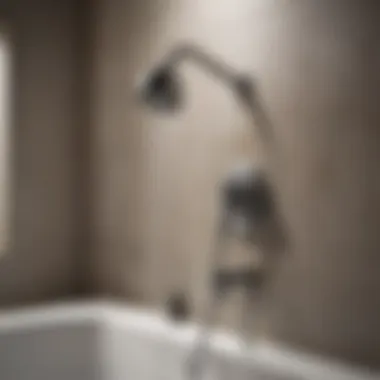
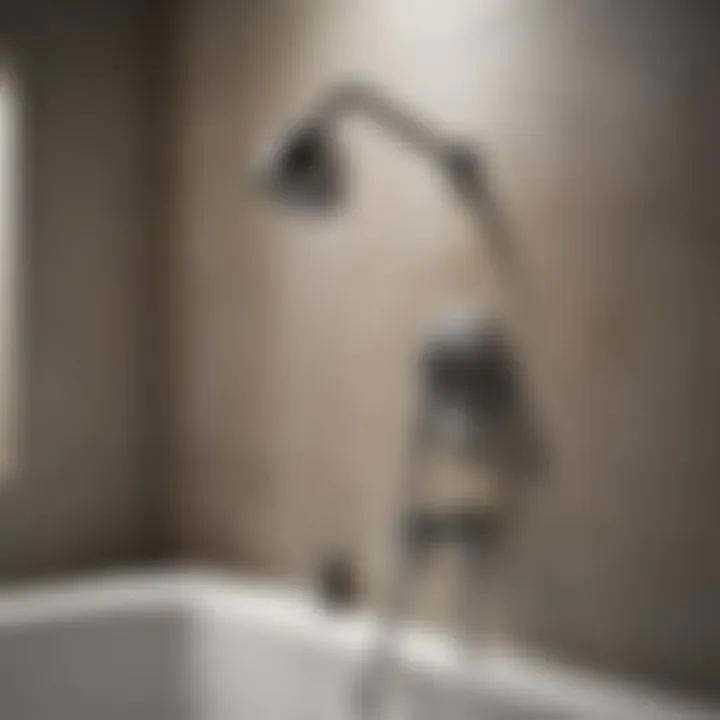
Advantages: They are aesthetically pleasing and often considered a high-end option that adds value to bathrooms.
Disadvantages: They can use more water than other types, which might not be the best choice for those looking for eco-friendly options.
Massaging Shower Heads
Massaging shower heads are designed to provide a targeted spray intended to relieve muscle tension and improve relaxation. This type of shower head has multiple settings that can adjust water flow to create a massaging effect, making them particularly popular after a long day.
Unique Feature: The ability to switch between different massage modes allows for a customized shower experience.
Advantages: They offer therapeutic benefits and can enhance relaxation during a shower.
Disadvantages: Some models may require more frequent cleaning due to potential mineral build-up from high-pressure settings.
Compatibility with Bath Taps
Understanding how shower heads interact with bath taps is essential for ensuring a smooth, effective bathing experience. Compatibility not only impacts the performance of the shower head but also influences water flow, pressure, and user satisfaction. Choosing a shower head that corresponds to your specific bath tap configuration guarantees efficient water usage and enhances overall comfort.
Understanding Bath Tap Configuration
Bath taps come in various designs and sizes. Familiarizing yourself with your specific bath tap configuration is crucial. This includes factors such as the attachment type, width, and threading. Knowing the details will help avoid purchasing incompatible products and potential installation headaches. When selecting a shower head, always check the installation requirements of your bath taps.
Identifying Compatible Shower Heads
Ensuring that your chosen shower head aligns with the bath tap is critical for a seamless integration. Two important aspects to consider in this regard are:
Thread Size
Thread size refers to the diameter of the opening where the shower head is attached to the bath tap. It is important because a mismatched thread size can lead to leaks or a poor fit. Most common thread sizes used in residential shower heads are 1/2 inch or 3/4 inch. A proper fit is essential as it allows for secure mounting, preventing any water wastage.
The primary characteristic of the thread size is its ability to standardize connections. This means that a large number of shower heads being manufactured today follow these common sizes, aiding consumers in finding a good match. The unique feature is the standardization which offers ease of installation and fitting with a variety of models.
However, it is key to measure before purchasing. Using a thread size that does not match can be a frustrating experience, resulting in additional costs and time to rectify. Thus, taking the extra measure to verify thread size is a beneficial practice.
Flow Rate
Flow rate pertains to the amount of water that flows through the shower head per minute, typically measured in gallons per minute (GPM). It plays an important role in the overall functionality of a shower head and people's bathing experience. A flow rate that is too high can result in wasted water, while a flow rate that is too low might not provide the cleansing or relaxation experience desired during a shower.
A common flow rate for shower heads is between 1.5 to 2.5 GPM. Having a shower head with an appropriate flow rate helps in achieving a balance between comfort and resource conservation. The unique feature of flow rate is its direct impact on water usage, which also aligns with eco-friendly practices.
When selecting a shower head, consider your existing plumbing system carefully. If the pressure is low, a high flow rate shower head could be inefficient, while a shower head meant for higher pressure might waste water in a low-pressure system. Ensuring that the flow rate matches your needs illuminates a pathway to a more satisfying bathing experience.
"Selecting the right shower head involves understanding both compatibility and efficiency, which can significantly improve your bathing ritual."
By paying attention to these factors, you can enhance your shower experience while ensuring that your chosen fixtures harmonize with the existing bath tap configuration.
Installation Process
The installation process of a shower head is a vital step in enhancing your bathing experience. Understanding how to properly install the shower head ensures it functions correctly and serves its intended purpose without causing leaks or other issues. A well-planned installation can greatly improve water flow and efficiency. Moreover, a straightforward installatio.n process can save you money, as it reduces the need for professional help.
Necessary Tools and Materials
Before beginning the installation, gather the necessary tools and materials to ensure a smooth process. The basic items you’ll need are:
- Adjustable wrench: To tighten or loosen the shower head.
- Plumber's tape: This helps create a watertight seal on the threads, preventing leaks.
- Screwdriver: Depending on your shower head, you may need a Phillips or flathead screwdriver.
- Bucket or towel: To catch any residual water that may drip during the process.
- New shower head: Choose one that matches your bath taps in compatibility.
Having these tools ready simplifies the process and minimizes unnecessary interruptions.
Step-by-Step Installation Instructions
The installation of a shower head typically follows a simple sequence. Here is a step-by-step guide to facilitate the installation process:
- Turn off the Water Supply: Locate the main water shut-off valve and turn it off to prevent water from flowing during the installation.
- Remove the Old Shower Head: Using the adjustable wrench, turn the old shower head counterclockwise to unscrew it from the bath tap. If it is stuck, you may need to apply a bit of force.
- Clean the Threads: Inspect the threads on the bath tap and clean off any debris or old plumber's tape to ensure a good seal for the new head.
- Apply Plumber's Tape: Wrap the plumber's tape clockwise around the threads of the bath tap. This tape aids in preventing leaks when the new shower head is installed.
- Attach the New Shower Head: Align the shower head with the threads on the bath tap. Carefully screw it on by hand to ensure it is correctly positioned, then use the wrench to tighten it without applying excessive force.
- Turn on the Water Supply: Once the shower head is secured, turn the water supply back on.
- Check for Leaks: Turn on the shower and check for any leaks at the connection point. If it leaks, turn off the water and ensure the installation has been done correctly.
Following these instructions will enable the effective installation of a shower head that enhances your bathing experience efficiently and reliably.
Maintenance of Shower Heads
Maintaining your shower head is crucial for several reasons. Proper maintenance ensures that your installation functions optimally and lasts longer, providing you with a better bathing experience. Over time, minerals from hard water can build up, affecting the water flow and pressure. Regular care helps mitigate these issues, keeping the water delivery consistent and enhancing the overall functionality.
Frequent cleaning also prevents the development of mold and mildew, which can be both unsightly and potentially harmful to health. By investing a small amount of time in maintenance, you can avoid costly repairs or replacements.
Cleaning Techniques

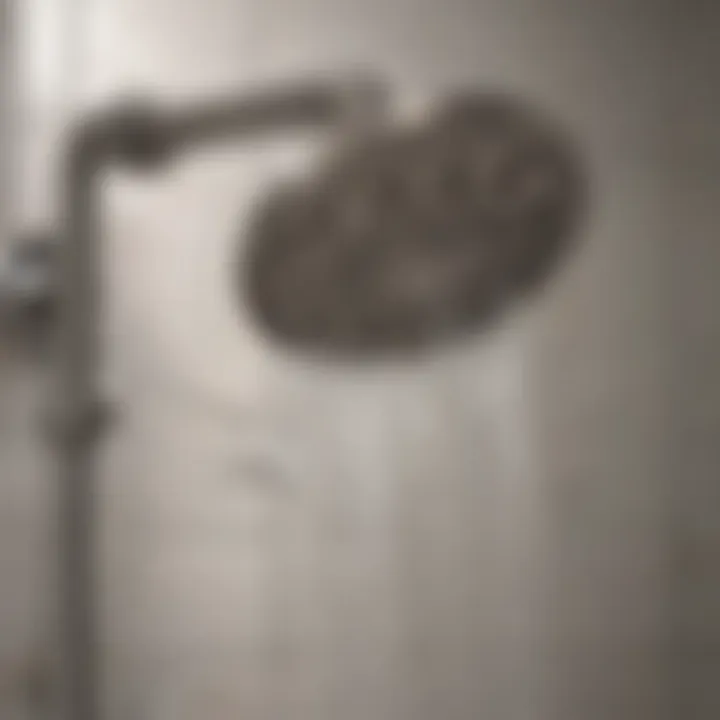
Cleaning your shower head should be part of your routine upkeep. There are simple ways to achieve this effectively:
- Vinegar Soak: Remove the shower head and soak it in white vinegar for several hours. This solution breaks down mineral deposits. After soaking, rinse it thoroughly before reattaching.
- Baking Soda Paste: For stubborn stains, mix baking soda with a small amount of water to form a paste. Apply the paste to the head and scrub gently with an old toothbrush.
- Use a Plastic Bag: If you cannot remove the shower head, you can fill a plastic bag with vinegar and secure it around the head using a rubber band. Leave it for a few hours.
- Regular Wipe-Downs: After each use, wipe down the exterior with a damp cloth. This prevents the buildup of soap scum and grime.
By adopting these simple techniques, you maintain the aesthetic and functional attributes of your shower head.
Common Issues and Troubleshooting
While shower heads are generally sturdy, some common issues may arise:
- Low Water Pressure: If you notice diminished water flow, it may be due to mineral buildup. Cleaning the fixture typically resolves this issue or consider checking if the flow restrictor needs adjustment.
- Leaks: Water dripping from the connection may suggest a loose fitting or degradation of the rubber seal. Tightening the connection or replacing the gasket can often fix this.
- Discoloration: This can happen due to tarnishing or mineral deposits. Cleaning with vinegar or a suitable cleaner will usually restore the original appearance.
- Water Temperature Fluctuations: If the water is not heated consistently, check the hot water supply lines for issues. Sometimes sediment can build up in the plumbing.
"Regular attention to maintenance will ensure that your shower head continues to perform at its best."
By addressing these common concerns through simple maintenance routines, you can not only prolong the life of your shower head but also ensure a more enjoyable bathing experience.
Choosing the Right Shower Head
Selecting the appropriate shower head is essential for enhancing the bathing experience. A good shower head can significantly affect comfort, water efficiency, and the overall aesthetic of your bathroom. Importance lies not only in functionality but also in personal preference. Taking the time to understand your options can lead to greater satisfaction and utility.
Factors to Consider
Material
The material of the shower head is a critical consideration. Common materials include stainless steel, plastic, and bronze. Stainless steel is popular due to its durability and corrosion resistance. It can withstand frequent use and various water conditions, which makes it a long-lasting choice. However, its weight may be a drawback for some users. Plastic shower heads, on the other hand, are lighter and often more affordable. They come in various designs but may not offer the same lifespan as metal options. Bronze is known for its aesthetic appeal and ability to resist tarnishing, yet it can be pricier. Overall, choosing the right material impacts not just longevity but also maintenance needs and aesthetic preferences.
Finish
The finish of the shower head plays a significant role in both functionality and visual appeal. Common finishes include chrome, brushed nickel, and oil-rubbed bronze. Chrome offers a shiny, reflective surface that is easy to clean, making it a popular choice among homeowners. However, it can show water spots and scratches more readily than other finishes. Brushed nickel is favored for its softer, matte look and higher resistance to fingerprints, making it suitable for families. Oil-rubbed bronze gives an antique appearance, adding character to the bathroom, but it might require more specific cleaning methods to maintain its look. Each finish holds its unique qualities that contribute to the overall bathroom style and user experience.
Design Style
When selecting a shower head, design style is equally vital. A sleek, contemporary design may suit a modern bathroom, while vintage styles can enhance traditional décor. Compact designs work well in smaller spaces, while larger, more embellished shower heads may serve as focal points in bigger bathrooms. The style must not only match the existing fixtures but also reflect personal taste. Additionally, the design can influence functionality. For example, adjustable shower heads cater to different user preferences, allowing customization during showers. Knowing the right design style will streamline the integration of the shower head into your bathing space.
Brand Recommendations
Selecting a reputable brand can ensure quality and performance. Moen offers a range of stylish and durable shower heads, well-suited for various tastes. Kohler is known for its innovative designs, focusing on user convenience and sustainability. Grohe emphasizes technology and German engineering, delivering reliable products. Other notable brands include Delta, recognized for its approachable technology, and Hansgrohe, which stands out for elevated design aesthetics. Choosing products from established brands typically guarantees a better user experience and may yield longer warranties.
Investing in a quality shower head can lead to better water savings and enhanced shower experience.
Impact on Bathing Experience
Selecting the right shower head significantly impacts the overall bathing experience. A shower head does more than just deliver water. It shapes how one feels during a bath, reflecting personal preferences and needs. When choosing a shower head, understanding its effects on water pressure and temperature is crucial. This not only affects comfort but can also influence water usage and efficiency, which many homeowners are becoming more aware of.
Water Pressure Considerations
Water pressure plays a critical role in the functionality of a shower head. High water pressure typically creates a more invigorating shower experience. This is especially important for individuals who prefer a strong pulsating flow that mimics a massage. Conversely, low water pressure may lead to a frustrating experience where water trickles instead of flows consistently. Understanding the water pressure in your home is vital.
Moreover, it is worth noting that certain shower heads are designed to accommodate lower water pressure. These models, often labeled as high-efficiency or low-flow, use technology to optimize the output without sacrificing comfort. Homeowners should evaluate both their plumbing system's capabilities and their personal showering preferences to determine the best fit.
"Choices in shower heads can vastly change the experience of bathing, impacting not just relaxation but also water efficiency."
Effect on Water Temperature
Another aspect of shower head selection involves the ability to maintain a stable water temperature. The material used in the construction of the shower head can influence how the water feels upon contact. Some materials conduct heat better than others, leading to temperature fluctuations, particularly if the water heater kicks on unexpectedly.
Equally important is the design of the shower head, as certain styles are better at retaining heat than others. For instance, systems designed with insulation can help keep the water warm longer. Homeowners should consider these elements to avoid sudden changes in temperature that could disrupt the bathing experience.
In summary, an optimal showering experience is achieved through careful consideration of water pressure and temperature management. Selecting the right shower head can elevate personal comfort and enhance the overall satisfaction of each bath.
Eco-Friendly Options
Eco-friendliness has become increasingly necessary in today's world. Selecting the right shower head can greatly influence water usage and energy consumption. Eco-friendly options not only save water but also lower utility bills and promote sustainability. Bathing can consume a lot of water, so choosing an efficient shower head can have a significant impact.
Water-Saving Shower Heads
Water-saving shower heads are designed to limit the amount of water used without compromising on quality. These products often feature flow restrictors that maintain steady water pressure while reducing flow rates. Common ratings for water-saving shower heads often range from 1.5 to 2.0 gallons per minute (GPM).
- Types of Water-Saving Technologies
- Aerating Shower Heads: Mix air with water, creating a mist-like spray that uses less water while providing adequate coverage.
- Laminar Flow Shower Heads: Produce a non-misting, strong stream of water which uses less water but may feel different compared to traditional showers.
- Smart Shower Heads: Adjust flow and temperature based on user preferences, optimizing water consumption smartly.
The installation of these shower heads is similar to standard models, making the switch easy for homeowners. Moreover, water-saving options can significantly enhance the overall bath experience, aligning balance between enjoyment and conservation.
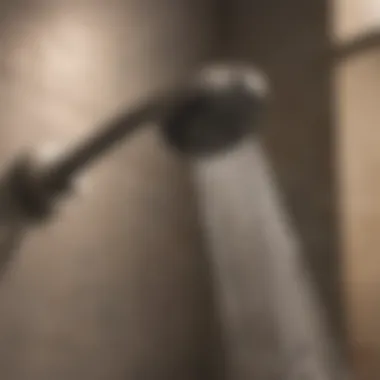
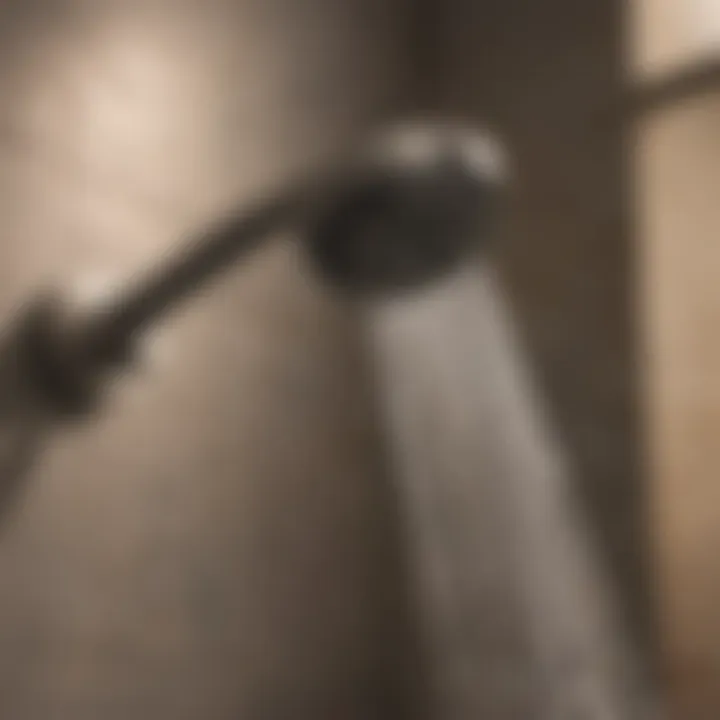
"Choosing water-saving options is not just about saving money; it's about protecting a vital resource."
Environmental Considerations
When considering eco-friendly showers, it is important to reflect on the broader environmental implications. Selecting water-efficient products contributes to sustainability and reduces greenhouse gas emissions associated with water heating. Reduced water flow leads to decreased energy required to heat water, thus lowering your carbon footprint.
- Reduced Water Demand: Showers account for nearly 17% of residential indoor water use. By installing water-saving shower heads, it is feasible to drastically cut down this percentage.
- Conservation of Resources: Every gallon of water saved helps in the conservation of vital (and often limited) water resources.
- Long-term Savings: Reduced water and energy consumption translates into lower utility costs over time.
User Preferences
Understanding user preferences is essential when selecting a shower head for bath taps. Each individual has unique needs and desires regarding their bathing experience. Incorporating these preferences can enhance comfort and satisfaction. Factors that influence these selections include aesthetic appeal, functionality, and overall design.
User preferences can greatly impact how effectively a shower head serves its purpose. Design styles play a significant role. Some homeowners may favor sleek, modern designs, while others may prefer more traditional looks. Matching the shower head to the existing decor enhances overall bathroom aesthetics. This personalization not only improves visual appeal but can also boost the value of the home.
In addition to design, functionality is a critical consideration. Users may desire specific features that cater to their lifestyle. For instance, a person with children might prioritize a shower head with a handheld option for ease of use, while someone who enjoys long, relaxing showers might prefer a rain shower for a spa-like experience.
"Choosing the right shower head can transform an ordinary bath into a luxurious retreat".
Personalization in Design
Personalization in design relates to how the selected shower head complements the overall style of the bathroom. Many options are available, from contemporary to vintage styles. This aspect allows for greater flexibility in selection.
Keeping in mind the existing bathroom fixtures is vital. Users should consider the finishes of their bath taps. If the taps have a chrome finish, a chrome shower head would blend well. Alternatively, if the desired look is more rustic, a matte black or brushed nickel can provide a striking contrast.
Additionally, some brands allow customization options, such as interchangeable faceplates or finishes. This functionality is particularly appealing for those who might want to switch styles without replacing the entire unit.
Adjustable Settings
Adjustable settings on shower heads cater to various preferences and needs. Such versatility is important because not everyone enjoys the same water pressure or spray pattern.
Most modern shower heads come equipped with multiple settings. These may include:
- Rainfall: This setting simulates a gentle and wide spread of water, ideal for relaxation.
- Massage: A focused spray that targets sore muscles, providing relief after a long day.
- Mist: A soft spray that is refreshing, particularly pleasant in hot weather.
Having adjustable settings means families can cater to multiple preferences without needing to install different shower heads. It also allows users to adapt their experience to their mood or specific needs at that moment. For instance, a quick rinse might require high pressure, while a soothing shower may call for a gentle mist.
Case Studies and User Testimonials
Case studies and user testimonials provide valuable insights when selecting a shower head for bath taps. Real experiences can highlight the impact of specific models on daily life. They enrich the advice by providing relatable scenarios. These narratives help potential buyers understand how products perform in various situations, which can alleviate uncertainties when making a purchase.
Real-Life Applications
Real-life applications of shower heads reveal how different designs and functionalities serve unique needs. For example, a family with children might prioritize a handheld shower head for easier bathing. Meanwhile, a couple might appreciate a rain shower head for a more luxurious experience.
Here are some notable cases:
- Family-Friendly Options: A user shared how they chose a handheld shower head due to its flexibility. Their children enjoy the freedom to wash themselves while ensuring that the parents can assist when necessary.
- Water Efficiency: Another consumer focused on a water-saving shower head. They reported a significant decrease in water usage without compromising water pressure. This not only benefitted their wallet but also aligned with their environmental values.
- Accessibility Needs: For individuals with mobility challenges, adjustable shower heads have been life-changing. One user described their experience of selecting a wall-mounted shower head with a longer reach, which allowed for easier bathing.
Such examples illustrate how the right choice can adapt to various lifestyles and preferences. They underline the necessity of assessing personal circumstances when selecting a product.
Feedback on Product Selection
Feedback from users can be immensely revealing about the suitability of shower heads for different situations. Many reviews on popular forums like Reddit and Facebook offer practical insights. Here are some common points noted by users:
- Installation Ease: Many users comment on how easy or difficult a product is to install. This information is essential for DIY enthusiasts or those who prefer to engage professionals.
- Durability: Consumers frequently discuss the longevity of their shower heads. Brands like Kohler and Moen receive praise for their robust constructions. In contrast, some budget brands face criticism for wear and tear.
- Water Pressure Experience: Several testimonials highlight how changes in shower head design directly affect water pressure sensation. A massaging shower head may provide a soothing experience while a rain shower might be perceived as gentle.
"Testimonies from real users offer practical insights into the longevity and efficiency of the products. They highlight both strengths and weaknesses, helping others make informed decisions."
By gathering these experiences and evaluations, potential buyers gain a more informed perspective. They see beyond the marketing claims, understanding actual performance in typical households. This collective feedback is invaluable in guiding future purchases.
Future Trends in Shower Heads
Understanding the future trends in shower heads is essential for anyone looking to enhance their bathing space. As technology advances, the way we utilize water in our homes undergoes significant changes. The evolving designs and functionalities of shower heads can provide benefits in efficiency, user experience, and overall aesthetic integration within modern bathrooms.
Technological Advancements
The introduction of smart technologies is revolutionizing shower heads. Many manufacturers are now integrating features that allow users to control water temperature and pressure through smartphone applications. User-friendly interfaces make adjustments easier and enhance comfort during showers.
These technological advancements aren't just about convenience. For instance, some shower heads come with built-in water-saving sensors. They monitor water usage and adjust flow rates accordingly, which not only conserves water but also reduces utility costs. Moreover, these smart showers often provide instant feedback and usage statistics to help households monitor their water consumption habits.
Furthermore, there are innovations like anti-scald technology, which helps prevent sudden changes in water temperature. This can be particularly beneficial for families with children or elderly members. Overall, technology in shower heads is about bringing safety, comfort, and efficiency to the forefront, making daily routines more enjoyable and eco-friendly.
Design Innovations
Design plays a crucial role in modern bathrooms and shower heads are no exception. The latest trends highlight sleek, minimalist designs that fit seamlessly into various bathroom aesthetics.
Manufacturers are using high-quality materials, such as stainless steel and brass, which not only enhance durability but also elevate the overall look of the fixture. Popular finishes like matte black, brushed nickel, or chrome provide homeowners with options to match their existing decor.
In addition to aesthetics, ergonomics are now at the center of design innovations. Features like rotating shower heads and adjustable heights allow for a more customized showering experience. Some recent designs even incorporate LED lighting that responds to water temperature, changing colors to indicate warmth thresholds.















